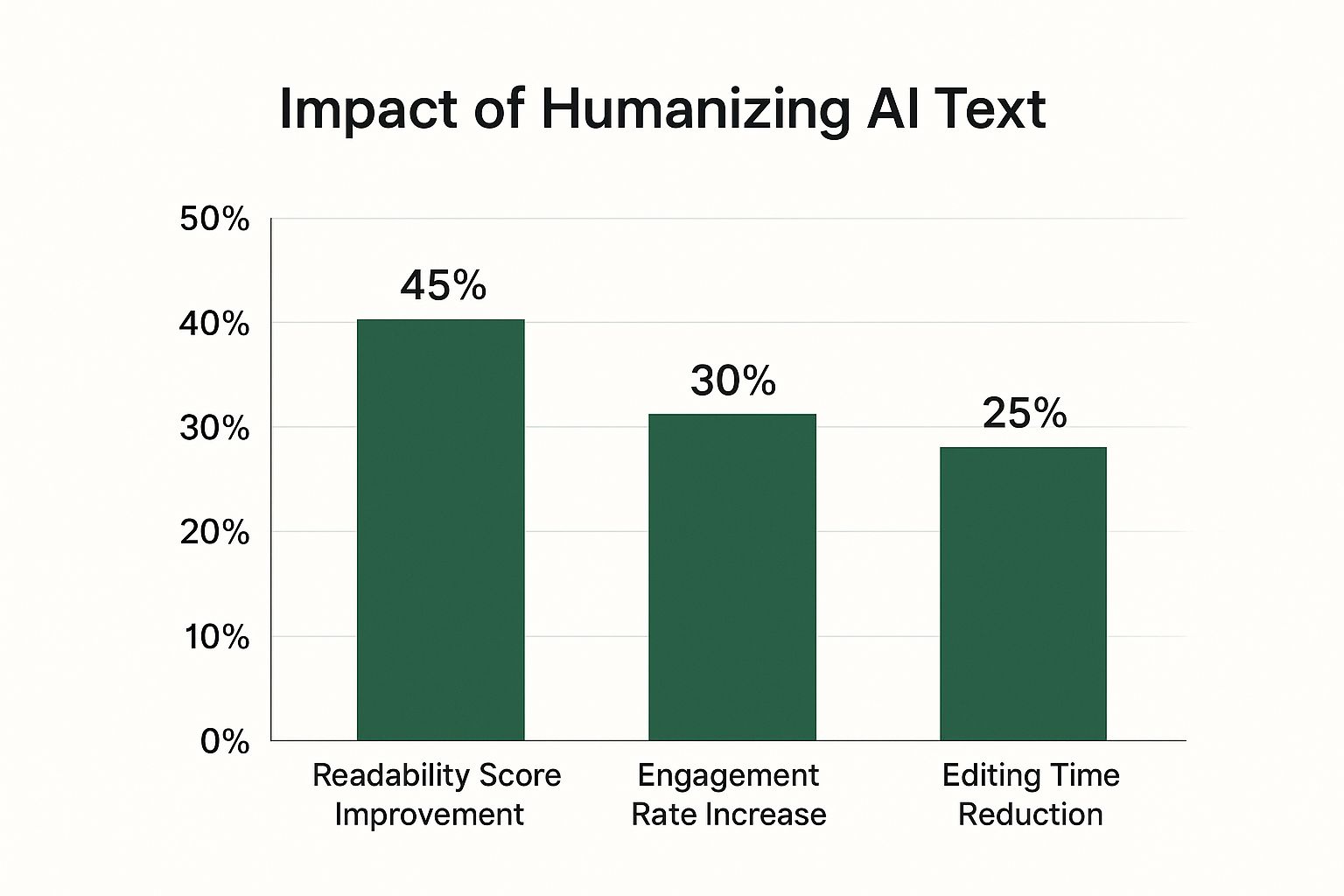
Convert AI Text to Human Text That Ranks
August 14, 2025
To really turn AI text into human-sounding content, you have to go way beyond just paraphrasing. It’s a full-on strategic editing process. This is where you inject your brand's unique voice, your hard-won insights, and a genuine personality that actually builds trust with your readers. That human touch is what makes content not just readable, but relatable.
Why Raw AI Content Fails to Connect
Let's be real—you can usually spot AI-generated content from a mile away. It has a certain… blandness to it. The language is often generic, it lacks a distinct voice, and you'll see the same predictable phrases and sentence structures over and over again.
Just hitting 'publish' on that raw output is a huge mistake.
The problem is that AI models are trained on gigantic datasets to predict the next logical word, not to forge a genuine connection with a human being. This creates content that might be grammatically flawless but feels emotionally sterile. It often explains the obvious and completely misses the unique, personal experiences that make writing truly compelling.
The Trust Factor
Authenticity is everything on the web today. Your audience is looking for content they can actually trust, and robotic text immediately puts up a wall. It lacks the subtle nuances, the opinions, and the storytelling that signal a real, thinking person is behind the words.
When raw AI content falls flat, humanizing it isn't just a "nice to have"—it's a necessity. This is how you increase social media engagement and build a loyal community that sticks around.
Moving Beyond AI Detection
Honestly, the goal isn't just to "beat" AI detectors. The real prize is creating content that truly resonates with your audience on a human level. This requires an editor—a human—to layer in the essential elements that algorithms simply can't replicate on their own.
- Your Brand Voice: This is where you inject your unique personality. Are you witty? Authoritative? Empathetic and friendly?
- Your Unique Insights: Add what you know from being in the trenches. This includes industry-specific knowledge and personal anecdotes that an AI could never have.
- Emotional Resonance: Use storytelling and shifts in tone to make your reader feel something.
The performance data really speaks for itself, showing the measurable benefits of taking this extra step.

As the chart shows, investing a little time to humanize your content delivers some serious returns, including a 45% jump in readability and a 30% lift in engagement.
To put it in perspective, here’s a quick look at how the key performance metrics stack up when you compare standard AI text to content that's been properly humanized.
AI Text vs Humanized Text Performance
| Metric | Standard AI Text | Humanized AI Text |
|---|---|---|
| Reader Engagement | Low | High |
| Conversion Rate | Low | Moderate to High |
| Brand Trust | Very Low | High |
| Readability Score | Moderate | Very High |
| Social Shares | Minimal | Increased |
The difference is pretty stark. Humanized content doesn't just read better; it performs better across the board by creating a genuine connection that machine-generated text simply can't match.
Spotting the Telltale Signs of AI Writing

Before you can effectively convert ai text to human text, you first have to get good at spotting it in the wild. Think of yourself as a detective. AI content often has little "tells" because it's built to predict the next word, not to tell a compelling story. It follows patterns.
One of the biggest giveaways is a heavy reliance on clunky transition words. You’ll see paragraphs starting with "Furthermore," "In addition," "Moreover," and the classic "In conclusion." While these words have their place, using them constantly creates a stiff, academic rhythm that just doesn't feel natural.
Another dead giveaway? Perfectly balanced but totally lifeless sentences. AI models love creating symmetrical sentences of almost the exact same length, which gets old fast. Real writers mix it up. They use short, punchy statements to make a point and longer sentences to explain things, creating a flow that keeps the reader engaged.
Uncovering Deeper AI Habits
Beyond just word choice and rhythm, AI writing often lacks personality. It’s great at summarizing things everyone already knows, but it falls flat when it comes to offering original insights or personal stories—the very things that connect you with an audience.
Look for these common AI writing habits:
- Explaining the Obvious: AI has a habit of stating things your readers definitely already know. Think of phrases like, "Search engine optimization (SEO) is important for online visibility." No kidding.
- Generic and Vague Advice: The recommendations are often so broad they’re useless. You’ll get tips like "create high-quality content" without any real guidance on what "high-quality" actually means for your specific topic.
- An Overly Formal Tone: Even when you ask for a casual tone, AI can slip back into a formal, detached voice. It steers clear of contractions and personal pronouns (I, we, you), making the writing feel distant and cold.
Pro Tip: Just read the text out loud. If it sounds like a robot from a 1950s movie—stiff, overly proper, and perfectly enunciated—it’s a huge red flag. Your ears will catch the awkward phrasing your eyes might have missed.
Your Practical AI Detection Checklist
To make this easier, run through a quick mental checklist whenever you're reviewing an AI draft. This simple exercise is the first real step to convert AI text to human text that actually connects.
Ask yourself:
- Does it share any personal stories or unique experiences?
- Is the sentence structure varied and interesting?
- Does the author actually have a strong, clear opinion?
- Is the language full of clichés and jargon?
- Are there specific, concrete examples instead of just general statements?
If you answered "no" to most of these, you have a perfect candidate for a human touch-up. Spotting these weaknesses is half the battle. Now you know exactly what needs fixing.
Alright, this is where the real magic happens. We've talked about spotting the robotic tells in AI writing, but now it's time to get our hands dirty and actually build a framework for turning that AI draft into something genuinely human.
Think of this less as a rigid, step-by-step formula and more as a flexible mindset. The goal is to infuse your content with an authentic voice—your voice.
Before you touch a single word, you have to know who you are. What's your brand's personality? Are you the witty, clever friend? The seasoned, authoritative expert? The warm, empathetic guide? Figure that out and write it down. It’s your north star for keeping everything consistent.
Once you have your voice defined, you can start weaving it into the AI-generated draft. This is where you bring in the stuff that machines just can't fake.
Add Your Unique Perspective
An AI is great at scraping the web for information, but it has no personal experiences to share. That’s your secret weapon. You need to actively look for spots to inject your own unique insights, opinions, and stories.
- Drop in personal anecdotes. Where can you add a quick story from your own life or work? Instead of a flat statement like, "customer feedback is important," try something like, "I'll never forget the time a client's feedback completely changed how we approached..." It’s instantly more compelling.
- Share niche-specific insights. AI tends to be generic. You're the expert in your field, so prove it. If you’re a plumber writing about leaky faucets, don't just talk about faucets. Mention the specific brands of washers you see failing all the time in your local area. That’s real value.
- Take a clear stance. AI is programmed to be neutral and wishy-washy. Don't be afraid to have an opinion. A sentence like "Some marketers prefer A, while others prefer B" is weak. A human editor changes it to, "While B has its merits, we've consistently seen A deliver a 20% higher ROI for our clients."
This kind of detail is a dead giveaway that a real person with real experience is behind the words. You can find more practical advice on this in our detailed guide on how to humanize AI text.
Authenticity isn't just about sounding human; it's about sharing a piece of your unique human experience. An AI can't attend a conference, have a difficult conversation with a client, or feel a surge of pride in a project well done. Use those moments.
Polish the Rhythm and Flow
Okay, with the substance beefed up, the next pass is all about the mechanics. We need to break up the monotonous, predictable sentence structures that scream "AI-generated!" and create a more natural, conversational rhythm.
Vary Your Sentence Length Mix it up. Use short, punchy sentences. Then follow them with longer, more descriptive ones. This creates a cadence that pulls the reader along and keeps them from getting bored.
Use Personal Pronouns Don't be shy about using "I," "we," and "you." These words instantly build a direct connection with your reader. It shifts the dynamic from a formal lecture to a one-on-one conversation, like you're sharing ideas instead of just broadcasting information.
The entire field of AI text conversion is moving incredibly fast. In specialized areas like AI-driven speech translation, we're seeing huge leaps in making AI outputs feel more human. By the end of 2025, it's expected that 35% of AI speech translation tools will use generalist models that can handle multiple tasks in one system—a big jump from just 20% the year before.
The final layer of polish? Add sensory details. Describe what you see, hear, or feel. This makes your writing come alive, helping your audience visualize your points and creating a much more memorable experience.
Elevating Your Content for SEO and Readability

Once you’ve injected your own authentic voice into an AI draft, the next step is getting it ready for search engines—and more importantly, the people who use them. A human touch and great SEO go hand-in-hand. This isn’t about just stuffing keywords into your text; it’s about the subtle, thoughtful optimization that makes content actually perform.
Humanizing is about connection, but you still need effective SEO strategies to get discovered in the first place. This is where a human editor becomes your secret weapon, spotting opportunities an algorithm would almost certainly miss. It means going beyond a single primary keyword to weave in related concepts and questions people are really asking.
Structuring for Search Success
Modern SEO is all about answering a user's intent completely. An article that's well-structured and easy to scan doesn't just make readers happy—it signals quality to search engines. Your job is to create the most helpful, user-friendly result out there.
Think about how you can format your content to snag those featured snippets. You know, those coveted answer boxes at the very top of the search results? They almost always pull from clearly organized lists, tables, or short paragraphs that give a direct answer to a specific question.
Here's what to focus on:
- Action-Oriented Subheadings: Write subheadings (H3s are great for this) that tell the reader exactly what they're about to learn. Instead of a generic heading like "Keywords," try something like "How to Weave in Semantic Keywords Naturally."
- Bulleted and Numbered Lists: Use lists to break down complicated ideas or step-by-step instructions. This kind of formatting is super scannable and a favorite for featured snippets.
- Direct Answers: Try starting a section with a direct, concise answer to a common question before you dive into the details. This is a powerful move for getting into the "People Also Ask" boxes.
A human editor can guess the follow-up questions a reader will have and build those answers right into the content. That deep understanding of user intent is what separates top-ranking content from everything else.
Boosting Readability for Better Engagement
Readability is a huge, if indirect, ranking factor. If someone clicks on your article and immediately bounces because they're hit with a wall of dense text, Google takes that as a sign that your page isn't offering a good experience. Humanizing your text for readability is a core part of the whole process.
This has become even more critical with the explosion of AI writing tools. As of 2025, an estimated 82% of businesses use AI writers, a massive leap from 45% just three years earlier. With 65% of marketing professionals now using them daily, making your content stand out with superior readability is non-negotiable.
To improve your content's flow and keep people on your page longer, focus on these simple but powerful tweaks:
- Keep paragraphs short. Seriously, aim for 1-3 sentences max. It makes a world of difference on mobile.
- Use bold text. It helps you emphasize key takeaways and important data points, guiding the reader’s eye.
- Vary your sentence structure. Mix short, punchy sentences with longer, more explanatory ones to create a natural rhythm.
This kind of detailed editing ensures your content isn't just found but is actually enjoyed. If you're still worried about your humanized text getting flagged by a detector, our guide on how to bypass AI detection offers some extra peace of mind.
Ultimately, the goal is to convert AI text to human text that serves both search engines and your audience perfectly.
Choosing the Right Humanizing Tools for Your Workflow
While nothing beats a good old-fashioned manual edit, the right software can absolutely speed things up. The market is flooded with tools that promise to convert AI text to human text, but they’re not all the same. Figuring out what each one does best is the first step to building a workflow that actually works.
Think of these tools as specialized assistants, not magic wands. They fall into a few main categories, and each has its own strengths and weaknesses. Some are just simple paraphrasers, while others are more advanced "humanizers" that can also tweak the tone and smooth out awkward phrasing.
Here’s a quick breakdown of what you'll find out there:
- Paraphrasing Tools: These are the most basic options. They're fantastic for quickly rewording a clunky sentence or finding a better synonym to avoid sounding repetitive. The catch? They often just swap out words without fixing the underlying robotic sentence structure.
- Tone and Style Adjusters: These tools analyze the feel of your text and help you shift it. For instance, you can take a stuffy, formal paragraph and make it sound more casual and conversational with just a few clicks.
- Dedicated "Humanizer" Platforms: This is a newer, more focused category. These platforms are specifically trained to spot and rewrite common AI patterns. They tackle issues like predictability, a flat voice, and overly complicated sentences all at once.
This screenshot shows the interface of QuillBot, a well-known paraphrasing and writing assistant, highlighting its different modes for rewriting text.

As you can see, even a straightforward tool like this gives you options like "Standard" and "Fluency" for more control over the final output.
Finding the Right Fit
The best tool for you really comes down to your needs and budget. A simple paraphraser might be all you need if you're just looking for help with occasional sentence rewrites. For anyone trying to seriously streamline their process, looking into the world of content automation can offer some great perspective on how these tools fit into a bigger picture.
But if your main goal is to consistently convert AI text to human text for high-stakes content like blog posts or marketing copy, a dedicated humanizer is usually worth the investment. These platforms are built from the ground up with the specific quirks of AI writing in mind.
Key Takeaway: No tool can add your personal stories, unique insights, or genuine opinions. They handle the grunt work of fixing robotic language, which frees you up to focus on the creative oversight and strategic additions that truly make the content yours.
For those just getting started, there are some excellent free options available, too. If you're after a no-cost solution, we have a complete guide on how you can humanize AI text for free using tools you can access right now.
Ultimately, a hybrid approach almost always works best. Use the tools to do the heavy lifting—fixing awkward phrasing, improving flow, and correcting robotic syntax. Then, you step in to add the irreplaceable human element. It's the perfect partnership.
Frequently Asked Questions About Humanizing AI Content
https://www.youtube.com/embed/jM2tdhZJxLU
Jumping into AI-assisted content creation opens up a lot of questions. As writers and marketers, we all want to figure out how to use these powerful tools without sacrificing quality or getting ourselves into trouble. Here are some straightforward answers to the questions I hear most often.
Will I Get an SEO Penalty for Using AI Content?
This is the big one. The short answer is no—not for using AI itself. Google has been pretty clear that it cares about the quality of the content, not who or what produced it. Robotic, low-value articles will perform poorly whether a machine or a human wrote them.
The trick is to convert AI text to human text that’s genuinely helpful, brings something new to the table, and gives the reader a good experience. If you use AI to get a first draft and then you step in to add your own insights, brand voice, and expertise, you’re just creating good content. And Google rewards good content.
Which Tools Are Best for Specific Humanizing Tasks?
There's no single magic bullet tool; it's all about matching the right tool to the job. Think of it like a mechanic's toolbox—you wouldn't use a sledgehammer to tighten a tiny screw.
- For Quick Rewording: A paraphrasing tool like QuillBot is perfect for fixing a single clunky sentence or finding a better word to avoid sounding repetitive.
- For Fixing Flow and Tone: More advanced platforms are built to analyze the overall rhythm and voice, turning stiff, academic text into something that flows like a natural conversation.
- For an All-in-One Solution: A dedicated humanizer is designed from the ground up to spot and rewrite common AI patterns. It tackles predictability, generic phrasing, and that tell-tale robotic feel all at once.
My most effective workflow is almost always a hybrid approach. I let a tool do the initial heavy lifting to fix the robotic language, then I put on my editor hat to add the strategic insights and personal touches that only a human can provide.
How Can I Keep a Consistent Brand Voice?
This is crucial. When you bring AI into your workflow, you have to be the guardian of your brand's unique voice. The best way I've found to do this is by creating a simple brand voice style guide before you even start editing.
This document doesn't have to be complicated. Just clearly define your:
- Tone: Are you witty and informal? Or are you authoritative and professional?
- Vocabulary: Are there specific words you lean on? Is there industry jargon you always avoid?
- Formatting Rules: Do you use contractions? The Oxford comma?
With these guidelines in hand, the human editing phase becomes so much more efficient. You’re no longer just vaguely "making it sound better." You're actively shaping the AI's raw output to perfectly match your established brand identity, keeping everything consistent.
Ready to transform your robotic drafts into compelling, natural-sounding content? Natural Write instantly refines your AI text, making it undetectable and ready to publish with just one click. Try it now and see the difference.


